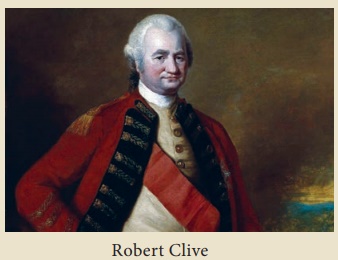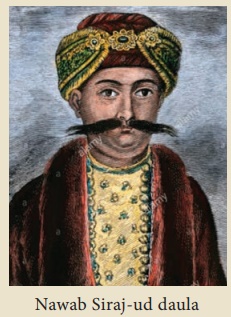Arrival of Europeans and the Aftermath - The Carnatic Wars | 11th History : Chapter 16 : The Coming of the Europeans
Chapter: 11th History : Chapter 16 : The Coming of the Europeans
The Carnatic Wars
The Carnatic Wars
The British had to fight three wars (1746-1763)
with the French to establish their supremacy, which in history are called the
Carnatic wars.
The Carnatic is a region in South
India lying between the Eastern Ghats and the Coromandel Coast. This region
constitutes the present day Tamil Nadu, eastern Karnataka, north-eastern Kerala
and southern Andhra Pradesh.
First Carnatic War 1746-48
The Austrian War of Succession and Seven Years War fought
in Europe had their repercussions in India. The Austrian ruler Charles VI died
in 1740 and was succeeded by his daughter Maria Theresa. France did not support
her succession and joined hands with German-speaking territories of Austria
such as Bavaria, Saxony and Spain. Frederick II (known as Frederick the Great
of Prussia) taking advantage of the emerging political situation invaded and
annexed Silesia, an Austrian province, with the support of France. The wars
fought between Britain and France in Europe also led to clashes between these
two countries over their colonial possessions in North America and India.

When the war broke out, the new Governor of
Pondicherry, Dupleix appealed to Morse, the Governor of Madras, to remain neutral.
But a British squadron under Commodore Barnett captured some of the French
vessels with Indian goods and precipitated the situation. Dupleix, shocked by
this incident, appealed to Anwar- ud-din, the Nawab of Carnatic, to help him to
avoid war with the English. Calm prevailed for some time.
Meanwhile Dupleix contacted La Bourdonnais, the
French Governor of Isle of France, who appeared in the Indian waters with eight
warships. Peyton, who led the English squadron with his four ships, intercepted
the French squadron and in the battle on 6 July 1746 Peyton suffered reverses
and retreated to Hoogly, Calcutta expecting some more ships from Britain.
Fall of Madras
The French squadron succeeded in capturing the
undefended Madras on 15 September 1746. Governor Morse was asked to surrender
but the Madras Governor turned to Anwar-ud-din for help. Dupleix was clever in
convincing the Nawab that he was securing Madras from the British to be handed
over to him. On 21 September 1746 the English were forced to part with Madras.
But when the Nawab of Carnatic asked the French to hand over Madras to him as
promised, the French dodged. Thereupon the Nawab sent a force of 10,000 men
under the command of his son Mahfuz Khan.
The Battle of San Thome and Adyar
Nawab’s forces blockaded Fort St. George but the
French forces pushed the Nawab’s forces to San Thome. The French received
reinforcement and Mahfuz Khan attempted to halt the progress of the French on
the banks of river Adyar. The French forces were able to wade through the water
and inflict a severe attack on the Nawab’s forces resulting in heavy losses.
Dupleix then set his eyes on Fort St. David at
Cuddalore which was in British possession. The English, with the help of the
Nawab of Arcot, was trying to regain the places lost but Dupleix again played a
diplomatic game by promising that he would hoist the flag of the Nawab in the
Fort St. George for a week and after that he requested the Nawab to hand over
the town to the French. The Nawab agreed to withdraw his proposed help to the
British. Two attempts of the British under Rear-Admiral Boscowen to take
Pondicherry failed. By this time, in 1748, France and the English had signed
the Treaty of Aix La Chapelle. Under this treaty the British and the French
ceased their hostilities in India. It was agreed that the French would hand
over Madras to the British in return for Louisburg in North America.
The Second Carnatic War: 1749-54
In Europe peace prevailed between the British and
the French. But the two colonial powers could not live in peace in India. They
played one native ruler against the other. Dupleix wanted to enhance the French
influence by involving in the wars of succession in both Hyderabad and Arcot.
Anandarangam Diary
Anandarangam (1709-1761), was born to
a leading merchant of the time named Tiruvengadam Pillai. After his father’s
death at Pondicherry, in view of the support given by the French Governors
Dumas and Dupleix became the greatest merchant at Pondicherry. Dupleix
appointed him the Chief Dubhashi (one who knows two languages) and Chief
Commercial Agent (1746) . This enabled him to emerge as a man of substantial
political influence at Pondicherry. But his real fame rests on his voluminous
Diary in Tamil which is a very valuable source of history for the period from
1736 to 1760, particularly for the Governorship of Dupleix. It is also a good
summary of Anandarangam’s views and impressions on contemporary events.
Dupleix supported the claims of Muzzafar Jung, the
grandson of Asaf Jah, who died in 1748 in Hyderabad, as the Nizam of Hyderabad.
In the Carnatic, he supported the claim of Chanda Sahib. A triple alliance was
formed amongst the French, Nizam and the Nawab of Carnatic.
The English, after losing Madras, a precious
possession, had only Fort St. David under their control. In order to reduce the
influence of the French, the English supported the rival candidates Nasir Jung
for the throne of Nizam of Hyderabad and that of Muhammad Ali after the death
of Anwar-ud-din in the Battle of Ambur in 1749.

The Battle of Ambur (1749)
The Battle of Ambur: Muzaffar Jung,
the contender for Nizami of
Hyderabad, and Chanda Sahib, a claimant to the Nawabi of Carnatic, with the
help of the disciplined French infantry inflicted huge casualties on the Nizam
and Anwar- ud-din’s forces. Anwar- ud-din was killed. Chanda Sahib entered
Arcot as the Nawab. Muhammad Ali, son of Anwar-ud-din, escaped to
Tiruchirappalli.
The battle of Ambur was followed by the entry of
victorious forces to Deccan. Nazir Jung was killed by the French Army and
Muzaffar Jung was made the Nizam of Hyderabad in December 1750. Dupleix’s dream
of establishing a French empire appeared good for some time. Dupleix received
huge money and territories both from the Nizam and the Nawab of Arcot. When
Muzaffar Jung required French protection, Dupleix sent Bussy, the French
general, with a large French force. Muzaffar Jung did not live long and the
same people who killed Nasir Jung also killed him. Bussy promptly placed
Salabat Jung, brother of Nazir Jung, on the throne. In order to reduce the
influence of British and also with a view to capturing Mohammad Ali (who fled
to Tiruchirappalli after Anwar-ud-din was killed) Chanda Sahib decided to take
Tiruchirappalli, with the help of the French and the Nizam.
Robert Clive was born in September
29, 1725. He had no interest in studies and was expelled from three schools for
his indiscipline and lack of interest in studies. However, Clive had developed
notoriety for fighting. Disgusted by his behaviour his father secured him a
writer’s post in the East India Company and sent him to Madras. Clive was later
promoted as the governor of Fort St David and was involved in the Carnatic Wars
and the siege of Trichinopoly. He won the Battle of Plassey in Bengal from
where the British Empire came to evolve in India. Clive returned to India to
take up his governorship and secured the Diwani rights from the defeated Mughal
emperor in 1765. Clive amassed huge wealth and left India a fabulously rich
man, with a personal fortune to the then value of 234, 000 pounds. This apart,
his jagir in Bengal fetched him an annual rental income of 27,000 pounds. When
he returned to England he faced a parliamentary inquiry over allegations of
corruption. Though exonerated, Clive committed suicide.

Clive in the Second Carnatic War
Dupleix was also determined to take over
Tiruchirappalli with the help of Chanda Sahib. Chanda Sahib’s troops were
joined by 900 Frenchmen. Muhammad Ali had only 5000 soldiers and not more than
600 Englishmen to help him. Robert Clive’s idea changed the course of history.
He suggested the idea of storming Arcot when the French and the Nawab were busy
concentrating on Tiruchirappalli.
Clive moved from Fort St. David on 26 August 1752
with only 200 English and 300 Indian soldiers. As expected the English received
help from many rulers from small territories. The Raja of Mysore and the ruler
of Thanjavur rallied to support Muhammad Ali. Chanda Sahib dispatched a force
of 3000 under his son Raja Sahib to take Arcot. Clive seized Arcot on August 31
and then successfully withstood a 53-day siege by Chanda Sahib’s son, Raja
Sahib, who was helped by the French forces. In the battle of Arni the English
and the Maratha ruler Murari Rao faced an unequal number of French and the
forces of Nawab of Arcot. In several battles that followed, including one at
Kaveripakkam, Chanda Sahib was captured and executed. Muhammed Ali became the
undisputed ruler of Carnatic.
In Europe Britain and France were not involved in
any war and so neither of them approved the policy of their Companies fighting
in India. The French government recalled Governor Dupleix. The Treaty of
Pondicherry was signed in 1755 with the English; both countries agreed not to
interfere in the quarrels of the Indian princes. The Treaty also defined their
mutual territorial possessions in India, a situation that was maintained for
nearly two centuries until Indian independence.
The Third Carnatic War: 1756-1763
The third Carnatic War was an echo of the Seven
Years War (1756-1763) which broke out in Europe in 1756. It was a global
conflict and was fought between the two arch-rivals Britain and France. The war
was fought in North America (resulting in the American War of Independence),
and West Africa (which later became the French West Africa) . In India it
manifested itself in the Third Carnatic war. Before turning our attention to
the Third Carnatic War, let us see what happened in Bengal in the meantime.
Battle of Plassey (1757)
The East India Company abused the trade permits (dastaks) granted by the Mughal Emperor
by not paying taxes to the Nawab of Bengal, and by involving itself in internal
trade. This apart, the Company had given asylum to the son of the Nawab
Siraj-ud-daula’s hostile aunt. As the Company refused to oblige the Nawab, who
demanded the return of his nephew, Fort St. William was captured and Europeans
imprisoned. Responding to this situation, the Company at Fort St. George
despatched a strong contingent under Robert Clive and Watson. The battle that
ensued is called the Battle of Plassey.
It was alleged that 146 European
prisoners were kept in a room measuring 18 by 15 feet and it is said that all
except 23 prisoners died of suffocation. The veracity of this incident, known
as the “Black Hole Tragedy of Calcutta” in British accounts, has been debated
among historians.

The battle of Plassey (1757) changed the position
of the British from being a commercial power to that of a territorial power. It
confirmed the privileges obtained by the Company and replaced Siraj-ud -daula
with the betrayer Mir Jaffar. The Company’s sovereignty over Calcutta was
recognized and it was given sufficient land to maintain a military force. Mir
Jaffar also agreed for a Company’s resident in the court. Mir Jaffar was
replaced by Mir Qasim and the latter tried to assert his independence, which
was not to the liking of the Company officials.
Battle of Buxar (1764)
After fleeing from Bengal Mir Qasim aligned with
the Mughal Emperor Shah Alam II and the Nawab of Oudh, Shuja-ud- daulah, who
were equally aggrieved by the interference of the Company in their internal
affairs. They declared war against the British. The battle was fought at Buxar
(1764). By virtue of its superior armed the Company forces won the battle. The
victory of the British led to the signing of the Treaty of Allahabad (1765) by
Robert Clive with Shah Alam II. By this treaty the Company got the Diwani right
to collect land revenue from the princely states of Bengal, Bihar and Orissa.
Besides, the Company obtained three districts, Burdwan, Chittagong and
Midnapur, in Bengal and sovereignty over Calcutta. British virtually became the
rulers of Bengal.

Outbreak of Third Carnatic War
With the outbreak of the Seven Years War, Clive
captured Chandranagore, the French settlement in Bengal. With this the French
influence ended in Bengal. But they retained their power in the south. The
French government sent Count de Lally as the Supreme Commander of the French
forces in India. As the British were active in Bengal, Lally promptly secured
Fort St. David after a short siege. Lally’s next move was Thanjavur but the
French were after money from the Raja which he could not give. Without a penny
the siege of Thanjavur was lifted because there was a threat of British attack
on Pondicherry.

Lally wanted Bussy to come from Hyderabad to help
him to defend Pondicherry in the case of attack. Bussy left Hyderabad and
joined Lally. In Deccan the political situation changed quickly and the French
lost both Rajahmundry (1758) and Masulipatam (1759). Salabat Jung, the Nizam of
Hyderabad, without fighting a battle signed an agreement with the British. The
Nizam transferred Masulipatam and Northern Circars from the French to the
English.
The combined forces of Bussy and Lally captured
Kanchipuram and proceeded to take Madras. As the British were busy in Bengal,
Madras had only about 800 Englishmen and 2500 Indian soldiers. The Siege of
Madras began on 12 December 1758. The French could not progress till February
1759, but both sides suffered casualties. The French, however, could not
continue with the siege as supplies were dwindling. Meanwhile General Pocock
brought a fleet to the relief of Madras. Lally was forced to lift the siege and
fall back on Kanchipuram.
The Battle of Wandiwash and the Fall of Pondicherry
Lally retired to Pondicherry leaving a French
contingent in Arcot. The British moved towards Wandiwash but suddenly fell upon
Kanchipuram and captured it. A fresh detachment of British forces arrived under
the command of Sir Eyre Coote. The last ditch battle was fought between Eyre
Coote and Lally at Wandawashi (Wandiwash) in January 1760. Bussy was defeated
and taken prisoner. Lally retreated to Pondicherry but it was not besieged
immediately. Meanwhile the British captured Senji and proceeded to Pondicherry
and laid siege to it. Lally had reorganized the defences and put up a heroic
resistance to the British. The siege of Pondicherry continued for several
months and finally on 4 February 1761 Pondicherry fell. In the same year the
British took control of Mahe, another French possession in the west coast. All
French possessions were now lost. Finally, the hostilities came to an end with
the signing of the Treaty of Paris (1763) at the end of the Seven Years War.
Pondicherry and Chandranagore were restored to the French. The French had to
henceforth be content with Pondicherry, Karaikal and Yanaon (Yanam) (all in
Union Territory of Puducherry), Mahe (Kannur district in Kerala), and
Chandranagore (Chandannagar in Bengal). The English emerged as the undisputed
colonial power in India, changing from a trading company into that of a
territorial power.
Related Topics